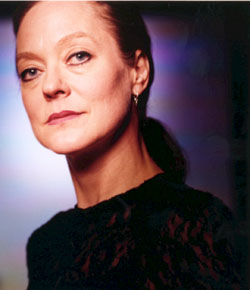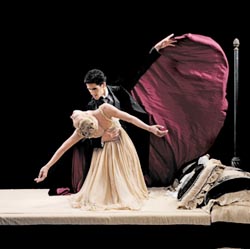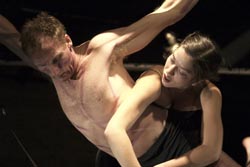For the past four years, the Prairie Dance Circuit (PDC) has boldly tackled the question of whether a particular aesthetic unique to Canada’s flatlands exists — or not.
The series’ latest offering was presented November 1 and 2, 2013 at Winnipeg’s Contemporary Dancers (WCD) Rachel Browne Theatre. It featured three eclectic new works that raise more questions than provide definitive answers. The brainchild of five Western Canadian artistic directors: Brian Webb (Edmonton’s Brian Webb Dance Company); Robin Poitras (Regina’s New Dance Horizons/Rouge-gorge); Calgary’s Davida Monk (Dancers’ Studio West) and Nicole Mion (Fluid Festival); and Brent Lott (Winnipeg’s Contemporary Dancers), PDC has scaled down from an annual touring network featuring (mostly) premieres from each of the creators’ hometowns to now featuring only one touring act juxtaposed with local works. This year’s instalment also kicked off WCD’s forty-ninth season and featured dance artists from Regina.
She — created for Poitras by Canadian dance royalty Paul-André Fortier — begins simply with the performer rocking back and forth on a straight-backed wooden chair. As her tempo gradually increases, the rhythmical movement hints at ecstatic exploration/release, a theme that runs throughout the twenty-five minute solo. Fortier’s highly theatrical works often include visually arresting sets that resemble postmodern sculptures. She proves to be no exception; in fact, the set’s starkly exposed bedspring frame, strung with piano wires and contact microphones, had originally been intended for Fortier’s acclaimed 2009 duet Cabane. After peeling back folded cloths to reveal the springs, Poitras (who is dressed in Daniel Storto’s paint-streaked white tunic and leggings) hands two cables to onstage technician Fraser MacKinnon who becomes her witness. As Poitras bounces, bangs, rolls, rubs, bows, strikes and beats the springs with her white-gloved fists, MacKinnon manipulates the sound through two small guitar amps to generate an unworldly, shrieking soundtrack.
Quirky humour abounds in this abstract, ambiguous work. At one point, Poitras twangs the bedsprings like a wannabe rock star. She holds cello and double bass bows above her head like antlers -– or antennae — and blows at an extracted bed slat as if it’s an ancient tribal horn. After hoisting the unwieldy frame on its side, she peers through its skeletal bars evoking the image of a prison cell -– it’s a riveting moment that speaks to both play and pain. The springs suggest a crib, a bed, a coffin; the veteran dancemaker’s artistry grounds the solo with an air of discovery. At the end of the dance, Poitras resumes her rocking on the chair, the rhythm of her hips accelerating once again before she sits bolt upright, at last coming to rest.
The second work on the program featured Regina-based dance artist Johanna Bundon and Toronto’s Bee Pallomina performing the understory (see their understory to the understory) . The work explores the isolation and interdependence of two women cast against a winter landscape. The gently lyrical duet has an evocative soundscape that includes crackling flames and howling winds; the set is also striking for its large tree branches resembling oversized bonsai positioned upstage.
What works best in this piece is the two dance artists’ imaginative devising of a naturalistic world: bundling themselves up in heavy cargo cloth, they become inert, stony boulders. At other times they morph into licking flames of fire dramatically lit by Parker Nowlan. The choreography includes floor rolls, crouches and, most memorably, wide-sweeping gestures where their arms extend like tree branches, fingers splayed like twigs. These potent images infuse the seventeen-minute work with such organic beauty that I would have been satisfied if the evening had ended right then and there. However, the spell is broken when Pallomina slowly rolls across the floor in a large rubber tire. Bundon’s head-scratching discourse on “tire-kickers,” based on definitions drawn from Wikipedia and Urban Dictionary becomes dryly didactic and I struggled to find meaning and relationship to what had come before. When the couple finally returns to their original, magical world, breaking into a flowing duet where they pivot and spin as though blown by the winds of change, my own sense of relief was real.
The program also featured the world premiere of Lott’s Entre Deux Mondes inspired by American poet Mary Oliver’s Wild Geese. The thirty-two-minute, cinema-inspired ensemble work explores loss, longing and the need for human connection by following a woman (WCD dancer Johanna Riley) caught between two worlds.This is a work that I wholeheartedly wanted to like. As a former WCD dancer, Lott has been enjoying a burgeoning choreographic career since taking the company’s helm in 2005. His full-length works, including 97 Positions of the Heart (2012) and Struck (2008), have been critically acclaimed. Still, I felt this latest work, in creation for two years, and with strong, committed dancing by Riley, Sam Penner, James Thomson Kacki and Sarah Helmer, felt underdeveloped.
The interdisciplinary work begins with Riley lying face down singing the gospel spiritual I told Jesus. This vehicle for the statuesque dancer’s powerful a cappella vocals becomes a leitmotif. Video artist Jaymez’s graphic projections include gnarly trees, a cityscape and starry night skies cast on an upstage screen. Designer Norma Lachance’s pedestrian costumes consist of black-heeled shoes, loose maroon-coloured trousers and shirts, with a simple red dress for Helmer.
Several choreographic choices (including an overabundance of unison movement in which the dancers high-step and pull their arms up their legs) are not well-integrated and diminish the additional visual layering created by the video images. I longed for greater complexity, more dynamic contrast between the individual movement vocabulary and the ensemble stage patterns. Riley is given more percussive kicks and abrupt direction changes during her duet with Thomson Kacki, which became particularly effective set against Montréal-based scratch DJ artist Kid Koala’s Space Cadet electro-acoustic score. But soon, a sense of predictability creeps in: solo sections morph into a duet; a duet becomes a trio, etcetera.
What Lott successfully creates is an atmosphere of elegiac longing. As a seated, pony-tailed Helmer observes the dancers from upstage, she seems like a newly departed spirit reviewing her own life in flashback. Her steady presence, punctuated at times by flailing limbs and twisting body that display her internal monologue, provides its own narrative arc. When she reaches out to embrace Riley at the end — the physical manifestation of her former self — the work gains even greater poignancy.
In any venture worth undertaking, true value ultimately lies not in the destination but in the journey itself. Although PDC may not be any closer to discovering any objective aesthetic truths, one thing is clear: by continuing its four-year exploration of what makes contemporary dance from Canada’s flatlands unique, more thought-provoking works will surely spring from the restless, creative dancemakers who call the Prairies home.
Tagged: Contemporary, Performance, MB , Winnipeg





